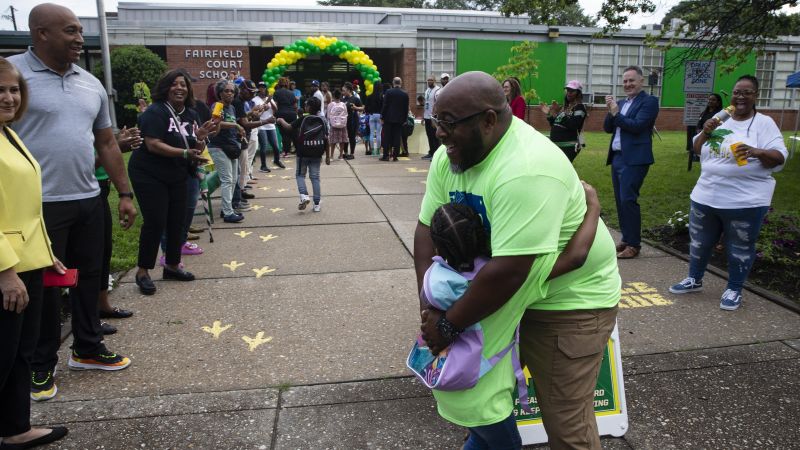Some kids in Houston got just a three-week summer break this year. In Richmond, Virginia, two elementary schools have added 20 days to the academic year. And in Indiana, students across the state have received more than 36,000 hours of tutoring over the past year, at no cost to their families.
Research has long shown that adding quality instruction time can have a significant impact on students’ academic achievement, though it may not always be easy to get students, teachers or parents on board with a longer school year, summer school or after-school tutoring.
But the significant learning loss experienced during the Covid-19 pandemic coupled with a historic federal investment in K-12 education made the timing ripe for some schools to make big changes. Between March 2020 and March 2021, Congress authorized $190 billion in funding for K-12 schools – roughly six times what they receive from the federal government in a normal year.
It’s too early to declare these new programs in Virginia, Texas and Indiana as success stories, but they are showing promising results – and could set the example for some significant changes at America’s schools.
Most of Richmond’s public school students returned on August 21 this year. But for roughly 1,000 families at two elementary schools, July 24 was the first day of the 2023-2024 school year.
The district added 20 days of school to help students at Fairfield Court and Cardinal elementary schools catch up after the pandemic.
“It’s something that we had been discussing for some time but were a little bit wary of taking it on pre-pandemic,” said Jason Kamras, superintendent of Richmond Public Schools.
“But coming out of the pandemic … our kids were really, really behind and we had to put everything on the table,” he said.
Twelve schools in the district applied for the pilot program to extend the school year, but just two showed they had support from the majority of families and teachers, which the district required to move forward. At Fairfield Court and Cardinal elementary schools, about 90% of families and teachers supported the plan.
A handful of teachers and a dozen families who did not want to participate in the extended school year were transferred to other schools in the district, Kamras said.
“Most of the families I spoke to were absolutely thrilled to be able to have their kids back in school,” he said.
The Fairfield Court and Cardinal schools serve many low-income and immigrant families, who may not have the money to take their kids on vacation, send them to camp or pay for child care during the summer, Kamras added.
The pilot program, which pays teachers a $10,000 bonus with a potential second bonus if benchmarks are met, is currently funded with federal money from the American Rescue Plan Act, a sweeping pandemic relief package that passed Congress in 2021. That school funding expires next September and other financial sources will be needed to continue providing longer school years.
Summer break was just three weeks for about 1,600 elementary school students in Houston this year.
Four elementary schools in the Aldine Independent School District, located on the north side of Houston, have added 30 days to the academic calendar. That means kids went back to school in mid-July and stayed through the end of the following June. Due to some calendar changes, the students are expected to get up to a six-week summer break next year even with the 30 additional days of school.
The schedule for the additional days looks different than on a traditional school day. While the hours are the same, more class time is directed at students’ individual needs, and there is more time for working on projects with peers. Each additional day also provides 210 minutes of accelerated math and reading learning time.
The Aldine Independent School District, where more than 90% of students come from low-income families that qualify for free or reduced-price lunch, started with two elementary schools extending the academic year in 2021-2022. Two more schools did so the following year, as it became clear that the pandemic exacerbated problems at low-performing districts.
So far, the results are promising, according to LaTonya Goffney, superintendent of Aldine Independent School District. One of the schools was the lowest-performing elementary school in the district before 2020 and is now one of the highest-performing, she said.
Plus, attendance at the schools that added days continue to be higher than at the other schools in the district.
A law passed by the Texas state legislature in 2019 helped pave the way to make an extended school year a reality. The law created a program known as Additional Days School Year, which covers half the cost of adding up to 30 days of instruction to the academic calendar. Schools serving pre-K through fifth grades are eligible.
The local school districts are on the hook for the rest of the cost. At Aldine, the federal Covid-19 relief funds weren’t used directly for the cost of adding days to the school year, but the aid freed up other funds to pay for the initiative, Goffney said.
When Aldine started bringing kids back for in-person learning in 2021, the additional school days seemed like the “perfect solution” to address learning loss, said Goffney.
Goffney admits she was nervous on that first day of school in July 2021.
“But the parents were there, they were happy. And the kids were happy to be out of the house. People were ready to come back,” she said.
Indiana is using federal pandemic aid to provide tutoring for students throughout the state in grades three through eight who come from low-income families and are struggling academically.
Dubbed Indiana Learns, the program connects families with tutors and provides $1,000 grants to cover the cost. About six months after the program launched in October 2022, the state made more funding available to families that have already used the $1,000.
Research shows that high-quality tutoring in small groups can have a substantial impact on pre-K-12 students.
Indiana families can use the Indiana Learns online platform to schedule tutoring in math or reading for their kids at a time and place that works for them. Sessions can be in person or online and are provided to students individually or in groups of up to four students per tutor.
“We wanted to really leverage the parents and the families to also be a part of this solution in supporting their child,” said Katie Jenner, Indiana’s secretary of education.
“It was a big bet. But there are so many students who were not passing our state assessments, whose families did not have that extra disposable income to support their child with tutoring,” she added.
So far, at least 15,000 students have enrolled in the program and completed more than 36,000 hours of tutoring with nearly 20,000 more hours scheduled, according to The Mind Trust, a nonprofit hired by the state to help run Indiana Learns.
The tutors are vetted by Mind Trust and come from a variety of places, including existing tutoring companies, current and retired teachers, and community groups, said Brandon Brown, CEO of The Mind Trust. Tutors cannot charge more than $100 per hour, and the average hourly rate is about $50.
Funding for the program will end in September 2024, when the American Rescue Plan Act requires states to have spent the federal pandemic funds. But the state could decide to provide its own funds if the program proves to be a good investment.
It’s unlikely all students will be caught up by the start of the next school year.
“I think learning loss during the pandemic is a national crisis, and I think it’s important for our country to treat it as such,” Brown said.
Read the full article here





